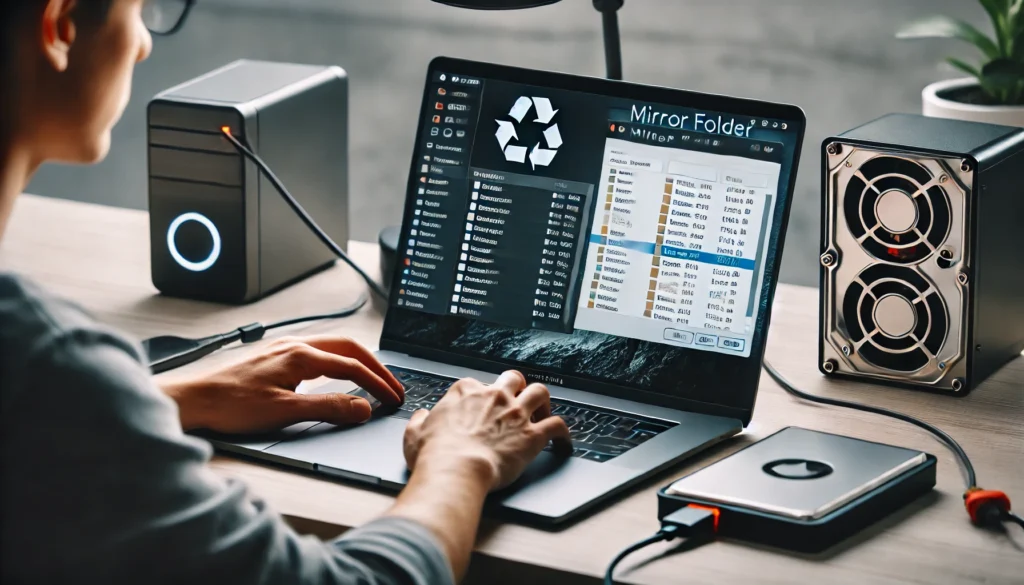
Introduction
In today’s data-driven world, the need for efficient and secure file management has never been greater. Whether you’re an individual managing personal files or a business handling sensitive data, having a reliable backup system is crucial. One of the most effective ways to ensure data security is through mirror folders. A mirror folder 42GB is a specific size configuration used to duplicate and synchronize data across different devices or storage solutions. In this guide, we will explore what a mirror folder is, how it works, and how the 42GB size can be particularly useful. Additionally, we’ll cover the setup process, software options, and best practices to optimize the usage of a mirror folder for your data needs.
What is a Mirror Folder?

A mirror folder is a folder that is automatically synchronized with another folder, ensuring that both contain identical data at all times. Unlike regular backups, where only changes to files are recorded, a mirror folder creates an exact copy of the original folder, maintaining real-time updates and mirroring every change. This means that when you add, delete, or modify a file in the original folder, those changes are immediately reflected in the mirrored copy.
How Does Mirroring Work?
Mirroring works by constantly monitoring the original folder for any changes. Once a change is detected, it automatically replicates that change in the mirror folder. Depending on the settings, mirroring can be one-way or two-way:
- One-way mirroring: Files are only updated in the mirror folder if changes are made to the original folder.
- Two-way mirroring: Changes made in either folder (the original or the mirrored) are synchronized between both locations.
This ensures that your data is always up-to-date and protected from any unforeseen data loss.
Why 42GB?
The 42GB size typically refers to the storage capacity required for the mirrored data. For most personal users or small businesses, a 42GB folder is large enough to store important files, documents, and media without overwhelming the system’s storage capacity. It also strikes a balance between providing enough space for data backup and not exceeding the storage limits of typical storage solutions such as external hard drives or cloud accounts.
Benefits of Using a Mirror Folder 42GB

There are several reasons why using a mirror folder is beneficial, particularly when dealing with a 42GB size. Let’s take a closer look at the advantages:
1. Real-Time Synchronization
The primary advantage of a mirror folder is its ability to synchronize files in real time. As soon as you make a change to your files—whether it’s adding a new file, deleting one, or updating an existing one—the mirror folder updates itself immediately. This ensures that both the original and mirrored versions of the folder are always identical.
2. Data Redundancy
One of the biggest threats to data integrity is data loss. Whether due to hardware failure, accidental deletion, or software corruption, losing critical files can be devastating. A mirror folder provides data redundancy, meaning that you always have an exact copy of your files stored in a separate location, ready to be accessed if something happens to the original.
3. Easy Disaster Recovery
In the event of data loss or system failure, mirror folders can act as a lifesaver. Since the mirrored copy is an exact replica of the original data, you can quickly recover your files without any major downtime. This is particularly valuable for businesses and professionals who rely on quick access to critical data.
4. Simplified File Management
With mirror folders, the process of backing up files becomes fully automated. You no longer need to manually copy files to external storage or cloud services. The mirror folder takes care of the backup process by itself, updating and syncing data automatically.
Setting Up a Mirror Folder 42GB

Setting up a mirror folder is a straightforward process that involves selecting the right software, configuring the synchronization settings, and ensuring you have the necessary storage capacity.
Prerequisites
Before you start setting up your mirror folder, ensure that you have the following:
- Sufficient Storage Space: At least 42GB of available storage on the device or cloud where the mirrored folder will be saved.
- Appropriate Software: You will need software that supports folder mirroring. Popular tools include MirrorFolder, FreeFileSync, and SyncBack.
Step-by-Step Guide to Setting Up a Mirror Folder
- Choose the Software: Select the mirroring software that fits your needs. For example, MirrorFolder is great for Windows users, while FreeFileSync is an open-source solution that works across multiple platforms.
- Install and Configure the Software: Once you’ve downloaded the software, install it and set it up to recognize the folder you want to mirror. During setup, choose whether you want one-way or two-way synchronization.
- Select the Storage Destination: Choose whether you want the mirrored folder to be stored locally on an external hard drive or in the cloud. Make sure the storage option has enough space for the 42GB of data.
- Run the Synchronization: After configuration, initiate the synchronization process. The software will begin mirroring the folder, making an exact copy on the designated storage.
- Automate the Process: Most mirroring software allows you to schedule regular syncs to ensure that your mirror folder stays up-to-date automatically. Set a schedule that works best for you.
Best Software and Tools for Mirror Folder 42GB
Choosing the right software to manage your mirror folder is crucial for ease of use and reliability. Here are some top-rated software options:
- MirrorFolder: An automated backup and mirroring tool that supports continuous file synchronization. It’s particularly good for businesses and users with large data needs.
- FreeFileSync: A free and open-source software that supports both local and cloud-based mirroring. It’s user-friendly and flexible for personal use.
- SyncBack: Known for its reliability and advanced features, SyncBack offers both free and paid versions, making it suitable for various needs.
Each of these tools offers unique features that cater to different types of users. Whether you’re looking for simplicity or more control over your mirroring process, there’s a solution for you.
Troubleshooting Common Issues
While using a mirror folder is a relatively hassle-free process, issues can arise. Here are some common problems and how to fix them:
- Sync Errors: Sometimes files may not sync correctly. Ensure that both the original and mirrored folders are accessible and that you have proper permissions for file access.
- Full Disk: If your storage device runs out of space, it can prevent new files from being mirrored. Regularly check your available space and upgrade storage if necessary.
- Network Issues (For Cloud Syncing): If you’re syncing to the cloud, network interruptions can cause delays or failures. Ensure a stable internet connection and try again if necessary.
Security and Privacy Concerns with Mirror Folders
When using mirror folders, particularly for sensitive data, security and privacy should be top priorities. Here are some tips to secure your mirrored data:
- Encryption: Use encryption tools to protect the data stored in your mirror folder, especially if you’re syncing sensitive or confidential files.
- Access Control: Make sure only authorized users can access the mirror folder, whether it’s stored locally or in the cloud.
- Cloud Security: If you’re syncing to the cloud, ensure the service uses strong encryption methods and two-factor authentication for an extra layer of protection.
Conclusion
A mirror folder 42GB is a powerful tool for anyone looking to ensure their data is safely backed up and always up-to-date. By understanding how it works, setting it up correctly, and choosing the right software, you can streamline your file management process while safeguarding your data from loss. Whether you’re using it for personal use or within a business, the benefits of real-time synchronization and disaster recovery are immense. By following best practices and troubleshooting tips, you’ll have peace of mind knowing that your data is secure and always available.
FAQs
Can I use a mirror folder for more than 42GB of data?
Yes, you can mirror folders larger than 42GB. However, ensure that you have sufficient storage space to accommodate the larger file size.
Is it possible to use multiple devices to mirror a folder?
Yes, you can sync your mirrored folder across multiple devices, such as a desktop and a laptop, ensuring that both have the same data.
Can I mirror files to a network-attached storage (NAS) device?
Yes, you can use a NAS for storing your mirrored folder. Many mirroring tools support NAS devices as a destination for backup.
How often should I update my mirror folder?
The frequency of updates depends on how often your data changes. Setting up automatic synchronization can ensure that your data is always backed up without manual intervention.
Does mirroring affect the performance of my system?
Mirroring large files can use system resources, but most tools allow you to adjust the sync schedule to minimize impact on performance.






